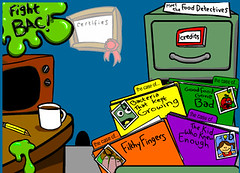Engaging Learning v. Gussied Up Instruction
I've wrestled with two approaches to the design of learning games. The first — and certainly the more engaging of the two approaches — is gameplay through which players learn by problem solving, critical thinking or behavioral practice (The Zoombinis games are perfect models of this). The second approach — and the one that is easier to develop — is gussied up learning where information may be presented in a fun way but is still 'given' to a game player, rather than learned on their own.
The first approach is more constructivist in nature: learners arrive at their own conclusions through research, experimentation or practice. I am biased towards this type of learning — I've always trusted knowledge I've earned myself more than facts presented to me.
In our Food Detectives Games we followed the second approach, presenting simple facts and information in an entertaining way. My dissertation research told me this approach to food safety education was effective: learners demonstrated in a pre/post knowledge assessment that they learned the basic food safety concepts taught. I was unable to measure behavioral change. I mean, sure... kids said they learned to wash their hands for 20 seconds... but did they really do it in the bathroom when no one was watching? In qualitative interviews, subjects conveyed they would rather learn this content through gameplay than lecture or reading. Is that enough?
- Is one approach better than another?
- Is the accolade "Learning content through gameplay is better than reading about it" really an argument for learning games development?
- Is it too demanding a standard that all game play integrate self-guided discovery?
- What makes a learning game successful... knowledge gain or time on topic?
My hope with the Food Detectives games is that kids spend more time playing the games than they would reading or listening to a class lecture on the content, thus they have more time with the content. I want them to internalize the information and make it their own (and we're working on another game to that end), but I'm not sure simply gussying up information is a failure, or a weak use of learning games. As game designers, what should we aspire too?


1 Comments:
"I'm not sure simply gussying up information is a failure, or a weak use of learning games. As game designers, what should we aspire to?"
And is aspiring to one or the other putting the cart before the horse? I'm not convinced that constructivist learning is an end unto itself. Instead, it seems like yet another tool in the toolbox which you can pull out to improve comprehension and retention, like mnemonic devices (songs), visual devices (illustrations and animations), or gameplay elements.
You can pick and choose the strategies you bring to bear on the student's learning experience - if a constructivist approach doesn't fit (whether it is because it is a topic that doesn't lend itself to that kind of learning, because you simply don't have the resources to develop that level of interaction, or because it would take too long in the classroom for the value of the lesson), then you probably shouldn't try to shoehorn it into your project for its own sake.
Post a Comment
<< Home